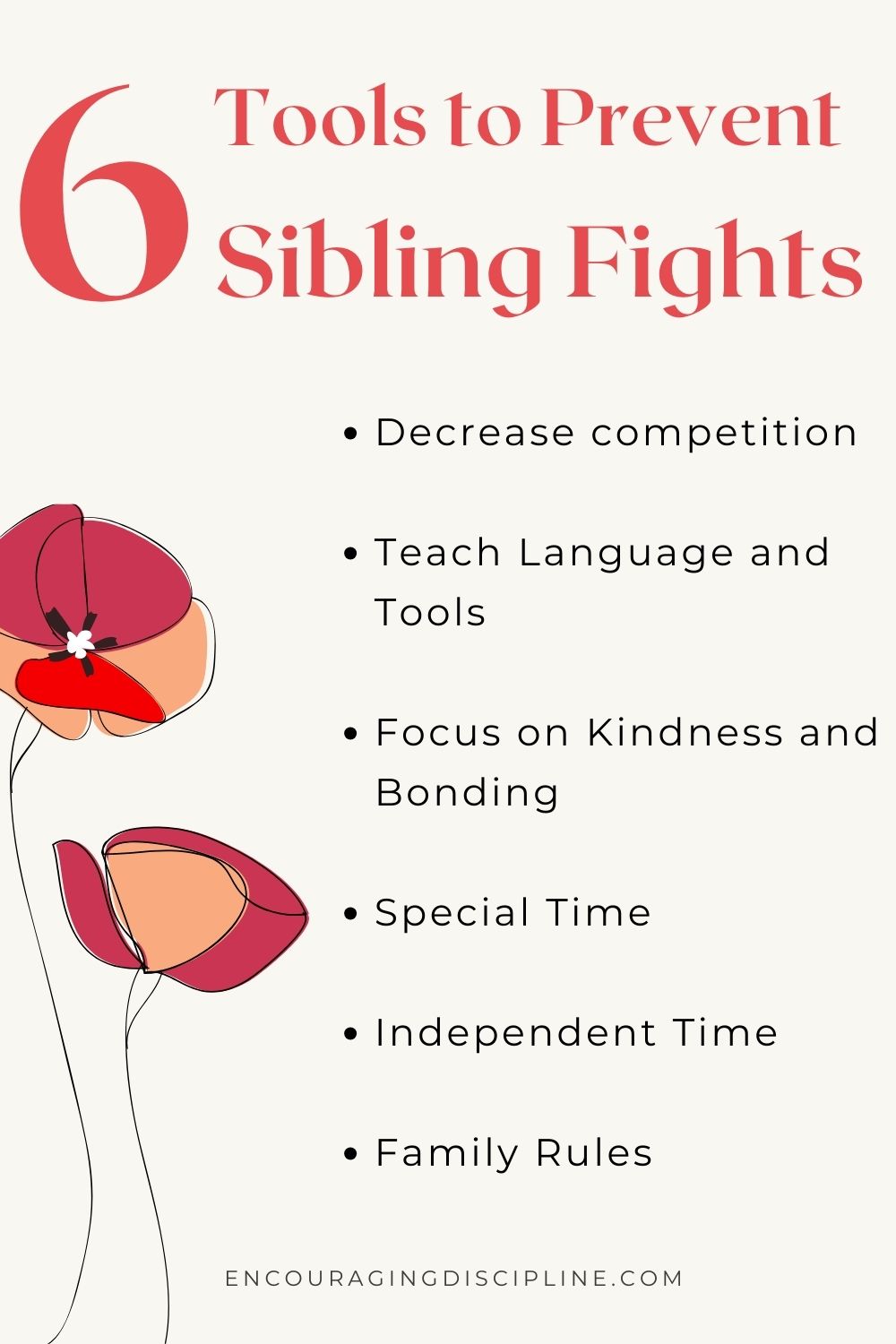How to Reduce Sibling Fights Easily
Before having children, did you imagine that they would be loving, close, fair, and sharing? Oh, and they would never fight? So did I. But if you are reading this post, then I am guessing your dream hasn’t come true. Don’t worry, though. Sibling fights are normal, and they can become less frequent and intense with time.
Table of Contents
What Doesn’t Work
When our children are squabbling, it can be very triggering. Especially because of the expectation stated above, that “good” siblings should never fight. And also, we might have been reprimanded and poorly guided in our own childhood whenever we had disagreements with our siblings.
So what do we do? We yell: “Stop fighting! Get along! Share!” Or: “That’s it! Time-out for both of you!” Sometimes, we may try solving the problem for them: “You each get the tablet for five minutes.” Other times, when our children don’t seem to listen, we may decide to take away their toys or screens or whatever they are fighting over.
However, as you’ve probably noticed, none of these options works. At least not in the long run. Your children continue to fight, and they don’t learn any conflict resolution skills.
Related: Getting Children to Play Alone
Why Do Siblings Fight?
First, let’s look at why children fight. You know they love each other, you’ve seen them sharing and being kind to one another countless times. What is it that gets into them sometimes?
There could be many reasons for this. Begin by doing a mental check to see if they could be hungry, tired, or coming down with an illness. Physical discomfort always makes it harder to find patience and generosity, even for adults.
If your children’s physical needs are met, then their emotional needs might be the culprit. Could they be feeling disconnected? Have you been busy lately and they haven’t gotten their daily dose of “mommy love” or “dad love”? Or they could feel disconnected from their sibling if he’s the one who’s gotten more attention lately.
Another reason why children may be “in the mood” for a fight is if they’ve had a tough day at school, or they are having a hard time dealing with some transitions.
If you know your children may be challenged in any of these areas, expect to see more conflict among them.
Tools to Prevent Conflicts Among Siblings
There are multiple things you can do to prevent sibling fights. We can work on decreasing competition, teaching children the language and tools to use during conflict, focusing on mutual love and bonding, special time, independent playtime, and family rules.

1. Decrease Competition
Sibling fights and competition can be decreased by avoiding labels and not taking sides or blaming.
Avoid Labeling Children
There are a few ways that we label our children.
- Sometimes we make comments about one of the children, with the intention of showing our pride in something the child is doing well. When I say to someone, “Our son is such a good drawer”, my daughter immediately asks, “Am I good at drawing too?” If we are not careful, kids will assume the opposite. “Oh, my parents just said my brother is a good drawer. They must think I am not.”
- Sometimes we make the mistake of labeling our children as “stubborn, wild, strong-willed”. While this may be true, we should avoid saying these things in front of them.
- Sometimes we think we can motivate them by comparing them with another child: “See how your brother picked up all his toys. Why can’t you do the same?” Their conclusion will always be “One is good, and the other one is bad”.
Avoid Taking Sides
In a disagreement, each child feels they are right. Therefore, if we intervene in an argument and decide that one is right and the other one is wrong, we pitch the children against each other. In general, children will not blame their parent for making an erroneous decision. But they will blame the other child they were in conflict with. This increases resentment and competition between the children because they feel that one is more loved than the other by the parent.
2. Teach Language and Tools
Teach Children the Language to Express Feelings and Needs
Teach children that, it is OK to feel anger, but that acting on it aggressively is not wise, because it can damage a relationship that is dear to them. Instead, teach them to express what they are feeling and needing with words. “I was playing with the race cars. You took them without asking. I don’t like that.” Or, “I want to read that book too. Can you give it to me when you are done with it?”
Related: Picture Books for Helping Kids With Anger
Teach Calm-Down Tools
Always teach calm-down tools when the children are calm and open to this conversation. Practice the tools together and explain to the children how they are better able to solve problems when they are calm. Then, when things get heated, remind them to use one of their favorite calm-down tools before they attempt to solve the problem.
Related: Teach Kids Effective Calm-Down Tools
Teach Conflict Resolution
Children are not born knowing how to solve conflicts. They need us to teach them strategies.
So, when they are calm and open, teach them how to find win-win solutions and compromise. Discuss with them different scenarios of frequent conflict and brainstorm together possible solutions. Allow the children to come up with as many alternative ways of solving a problem as they can. You can add to their list of options and create a wheel of choice.
Here are some ideas:
- taking turns for an agreed-upon amount of time,
- choosing another game if they can’t decide which game to play,
- doing rock-paper-scissors,
- taking a few minutes apart,
- playing individually for a while, and so on.
Write down the suggested solutions and revisit them occasionally. Your children will be more likely to remember and try to use those solutions to solve problems when they need to.
3. Focus on Kindness and Bonding
Create Opportunities for Expressing Kindness
- Frequently, find opportunities for everyone to express gratitude and appreciation for the other members of the family.
- When one of your children needs help, invite the other child to help.
- Try to notice when they are nice to each other: “Wow, you drew that for your sister while you were at school? You love her so much!”
- Tell stories about when they showed their love for each other: “When you were little, your sister used to love rocking you in your bouncer”, or “When your brother was a baby, his face used to light up whenever you entered the room. He would always laugh at your silly faces.”
Play “You Against Them”
Have your children make a team and play against you. You can play tag and either you have to catch them, or, even better, they have to catch you. Your children will work together to trick you and “get you”. This type of teamwork builds a camaraderie between children that is sure to reduce fights.
4. Special Time
Schedule Special Time for connection. As often as you can, plan to give each child individual time with you. The child gets to decide what you will play together and make all play-related decisions. For Special Time to work, it is important that you be all in, fully present, and follow the child’s lead. During Special Time, children get to reconnect with us and also offload unpleasant feelings that have been bothering them. After Special Time, they can return to their sibling and play with more calm and willingness to cooperate.
Related: How to Get Better Behavior With Special Time
5. Independent Time
Allow each child a few minutes of independent time. They can choose to do whatever they want during that time. They can play, read, color, or rest. This might be a little hard for an extroverted child, but it can be essential for an introverted one. With time, even your extroverted child will learn to appreciate ten minutes on their own.
Have each child pick a space where they can retreat every day. Eventually, you will notice that your child will enjoy going to his safe spot by themselves when they feel overwhelmed.
After recharging in this way, children will be better able to play together longer without fighting.
6. Family Rules
Another part of preventing sibling fights is clarifying and talking frequently about family rules. These should represent your family values and they may be different for every family. Some of them may include:
- Don’t hurt myself
- Don’t hurt others
- Don’t destroy things
- If I don’t feel safe, I can get a parent
- If I need help solving a problem, I can get a parent.
By implementing even some of these prevention tools, you will see a decrease in sibling fights and conflict. Your children will feel more connected to you and their siblings and more secure in your love. Additionally, by having the language to use, clear family rules, and tools to use, your children will feel more confident and calm.
How to Intervene in Sibling Fights
While you will see a decrease in the frequency and intensity of sibling fights, the squabbles will not disappear entirely. And sometimes your children will not have the resources to figure things out on their own, so you will need to intervene.
Step One – Awareness
Check in with yourself and notice how you are feeling. Are there any tense areas in your body? Are there any feelings rising inside? Breathe and release tension. Then decide to keep quiet. Remind yourself to pause and listen.
Step Two – Safety
Walk over to the kids. Firmly and gently get between the children if they are physically aggressive. Move them away from each other and keep them apart. You want to make sure they are not hurting each other.
Step Three – Connect
Ask calmly, “What’s going on?” Allow each child to take turns telling you their side of the story. You just listen and repeat what they are telling you to make sure they agree with what you understood from their story.
Empathize with each child sincerely, and really try to see their point of view. Your job here is not to solve the problem, but rather to listen to your children’s frustrations and empathize with them. If they release some of their feelings, they will be able to better think about how to solve the problem themselves.
If the children are too wound up and can’t work on a solution cordially, then call a time-out. Tell children calmly that you all need some time to calm down first so you can find a reasonable solution together later. Ask them if they would like to go to their safe spots.
Step Four – Guide
When everyone is a bit calmer and ready to talk, invite children to suggest ways to solve the problem. Maybe they forgot to use their words, and they can now ask their sibling nicely for the toy, or maybe they can apologize for breaking the Lego construction their sibling made, and so on.
The important thing here is for you to not offer unsolicited solutions. The only time this is reasonable is when children seem stuck. But if you offer your children time to work out their differences, you will be surprised by how creative they can be.
Reminders
Another important point that I want to make here is to not force an apology. You may ask your children if they would like to apologize, but forcing them to apologize will only fuel resentment.
Related: Getting Children to Apologize Sincerely
Also, avoid blaming. Remember, both your children are right. They do not act the way they do for no reason at all. Your job is to love and guide them both or all.
Conclusion
To clarify, by using all these prevention and intervention tools, sibling fights will not disappear completely. And you shouldn’t wish for that to happen – sibling rivalry has an important role in your children’s development. But you also shouldn’t allow them to become destructive and traumatizing, where the stronger child always wins and gets what he or she wants.
However, the conflicts will make sense, you will have a better idea of why they are happening, and your children will learn problem-solving skills that will benefit them for life. If you model a neutral intervention, your children will eventually learn how to solve conflicts without blaming and becoming aggressive physically or verbally.
Navigating differing interests and conflicts is a very advanced skill. Give children enough modeling, guidance, and time to learn how to use it successfully. Trust that they will learn in their own time.
What would it mean for you if your children played together without fighting? Let me know in the comments.







